Jordan Peterson’s Biblical Series II
Genesis 1: Chaos & Order
In May 2017 Dr. Jordan B. Peterson began his 12-part lecture series on the Psychological Significance of the Biblical Stories. With this lecture series he aims to try to better understand and learn about the stories, and the continual impact they have had on civilization. This is part 2 of that lecture.
You can view the transcript of his video here
Trying to glean any understanding for the psychology behind the Biblical stories, or the individuals who may have written it, is like trying to define and understand consciousness; it doesn’t matter how hard you try, you will never be able to wrap your head around all of the possibilities. We simply are not at a place in which we can understand something so complex and subjective. Although each individual experiences consciousness, and we can assume certain defining characteristics, there is still so much that we don’t know. Similarly, there is much in which we do not know about the Biblical stories, like who wrote them, why they were written, or how they’ve managed to be so influential and hang around this long.
“If a movie is running, and no one’s watching it, in what sense can you say that there’s even a movie running? Because the movie seems to be the experience of the movie, not the objective elements of the movie.” What Peterson is trying to get at with this particular analogy (which is not the same as the tree in the forest analogy, as he points out), is that there is something about reality, which is dependent on the conscious experience of the world.
Physicists like, John Wheeler, believed that consciousness plays a constructive role in transforming the chaotic potential of being, into the actuality of being. What this means is that with consciousness, we are able to take the chaotic and limitless potential for life, and shape it into actual experience and reality. A concept which is quite similar to the idea of the ‘Word’, which is the force God used to extract habitable order out of chaos at the beginning of time, just as individuals have the ability to take the chaotic potential of their own lives, future, as well as the world around them, and shape it.
The biblical stories are what Peterson says you may describe as unchanging, or transcendent. They’re archetypal, retelling what is common across all human experiences. They transcend fiction because they tell stories that are true for everyone in some sense. The story of Adam and Eve, for example, is quite archetypal because everyone inhabits metaphorical walled gardens, which protect us from the unknown horrors. But it’s an incredibly unstable place, and you can be knocked out of it in an instant by something unforeseen when Adam and Eve ate the apple and were thrown out of paradise. It’s is more than that they were thrown out of paradise though, when they ate the apple, they became self-conscious and aware that they’re naked. The traditional interpretation of this knowledge and subsequent shame is that it has something to do with sexual sin. Peterson disagrees, however, pointing out that if you have a dream where you’re standing naked in front of a crowd of people, it’s not typically a sexual dream.
To be naked in front of a crowd is to be exposed and vulnerable to the judgment of the social world, and people don’t typically like being exposed to scrutiny.
Elements of World Mythology
When looking at mythology, one does not have to look far to find common and recurring elements within the stories. One of these common elements is the rule of three. Whether it’s three cute but naive pigs, three trials in which the hero must endure, the Holy Trinity, the rule of three is a common theme. This also holds true for many creation and world mythologies, Genesis is no exception. The first of the three elements which make up being is the formless potential, generally given a feminine nature. The second element is a sort of interpretive structure which contests with the formless potential. This structure is inherent already exists within you, without it you wouldn’t be able to take the formless potential that is your existence and do anything with it. The final element, according to Peterson, is something like consciousness that inheres to the individual.
It seems the Trinitarian notion within Christianity is something like the formless potential, and then there is a prior interpretive structure inherent to us as a consequence of our ancestral beings. Finally, there is the concept of consciousness, which is a tool of that structure so that it can interact with the world and give it a reality. Which as far as Peterson can tell, is similar to the concept of the Word.
There is this notion within Christianity that Christ, and the word, were one and the same, the element which God used to speak chaos into habitable order. So you have the notion of the Father, that’s the structure, and then there’s Son which is transcendent and characterizes consciousness. And it’s the speaking of the son, or the word, which turns chaos into order.
Genesis I
In the beginning, God created the heavens and the earth. The earth was without form and void, and darkness was over the face of the deep. And the Spirit of God was hovering over the face of the waters.
Starting with the first lines of Genesis, Peterson begins his analysis of the biblical story of creation by looking at some of the older stories which influence these lines. These interpretations are often lost in translation, and while he doesn’t speak those languages, he has had access to secondary sources and is able to delve deeper into the stories. Throughout the first few lines, there is an emphasis on this idea of the deep and formless void, and this is associated with the notion of endless potential. One of the words that represent “without form and void” is Tehom, which is also associated with an earlier Mesopotamian word, Tiamat.
Tiamat was a dragon who represented the salt water in Mesopotamian mythology and had a husband named Apsu. Apsu and Tiamat were said to be locked together in an intimate embrace, much like chaos and order, and it was their union that brought about the old Gods first, and eventually humanity itself.
Peterson touched on another story of Tiamat in the previous lecture. Within that it, Marduk confronts Tiamat, who represents chaos coming forward once again, and carves her up into pieces, which he then uses to create the earth. Much like in the Mesopotamian story, Peterson points out an idea which is hidden within the initial lines of Genesis. The idea that “God is something akin to that which confronts the unknown, and carves it into pieces, and makes the world out of its pieces.” This is not all that much unlike how human beings created our world. We went out beyond our confined comfort zones and ventured out into the unknown.
Peterson remarks that there is no difference between the conquering of the unknown and the creation of habitable order. He believes that as our cognitive faculties have developed, and we’ve gained the capability for high levels of abstraction, we’ve begun using abstracted versions of the same circuits in order to make a jointly habitable space in order to exist with others. Just like how our ancient ancestors voyaged out to the unknown to carve out a life, we venture into a metaphorical unknown when we try to create a life with another person. This also explains why we are often so quick to demonize those who we consider our enemies. Our enemies oppose us and confront us with what we do not want to see. So, we use an abstracted form of predator deception on them, and this causes us to almost instantly demonize them.
Circling back to the phrase “without form and void” in the initial lines, Peterson gives examples of how one might experience the formless chaos of potential personally, and how the order in which you currently inhabit can dissolve into it. He references Dante’s Inferno, where Dante outlines the levels of hell and is trying to get to the core of what constituted evil. In other words, what was the worst possible type of behavior a person could engage in? Dante came to believe that it was betrayal, and Peterson agrees, he believes it is the “fundamental natural resource”. Trust is one of the main elements required for a long term, peaceful cooperation between people. The thing is that humans are incredibly complicated, often times not even truly knowing and understanding themselves personally. Part of the necessity of having trust in a relationship is that it gives the ability to simplify someone to their word, and gives the illusion that we understand each other. If you’re in a relationship with someone who you trust, then you make assumptions about the past, and about the future. The example Peterson uses is, when you trust someone then you think you’re standing on solid ground, but it’s more like thin ice. The chaos is hidden, it’s the shark beneath that you can’t quite see. When you’re betrayed, you go from a place where everything is secure, to somewhere where everything is foreign and unknown.
When someone is betrayed, they fall into this realm of unknown and doubt, which is something akin to the mythological unknown. And this is where feelings of resentment, destruction, and harm. If someone is betrayed to the point where they begin to nurse fantasies of the ultimate revenge, then they have reached a point in the metaphorical underworld which is essentially hell.
And God said, “Let there be light,” and there was light. And God saw that the light was good. And God separated the light from the darkness. God called the light Day, and the darkness he called Night. And there was evening and there was morning, the first day.
Day and night are, as Peterson describes them, “two of the fundamental elements of our conscious being.” We are active and alert during the day when it’s light, and asleep usually during the night while it is dark. This is partly due to the fact that we are highly visual creatures, while most other animals rely on smell. Vision is often associated with enlightenment, illumination, and rebirth. And so, it is that “for light to be created is associated, in some sense, with the emergence of conscious being.” Peterson brings up the phrasing for the story as well, and touches on the importance of the fact that God “said.” “That is the use of the Word or the active element of the structure that gives order to chaos.”
It’s also significant that things are named. As we will see in the story of Adam and Eve, God tasks Adam with naming all of the animals. It’s almost as if, in a sense, the animals don’t truly exist until they’re given a name. By giving something a name, you transform it from something that is pure potential, into something defined and tangible, and there’s a clear and continued emphasis on the importance of conscious, articulated speech throughout the story. It’s one of the main things that separates us from animals, although we’ve been able to teach parrots to speak up the level of a four-year-old, and we can teach chimpanzees sign language, we’ve also found that they don’t have the capacity for language like we do, and they lack the ability to pass it on to the next generation.
And God said, “let there be an expanse in the midst of the waters, and let it separate the waters from the waters.” And God made the expanse. And it was so, And God called the expanse heaven. And there was evening and there was morning, the second day.
The world in which is being created in this story is, as Peterson puts it, a phenomenological world. It is a disk of land, which sets inside of a dome. Outside of this dome, as well as underneath the disk there is water, and surrounding it there is the salt water. This interpretation of the world is a healthy mix of observation and imagination, it is not the natural world as scientists would describe it.
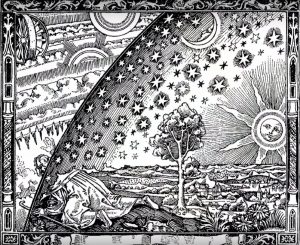 Peterson shares the drawing The Sun, Moon, and Stars by Camille Flammarion. In it is a man who is mostly within the dome or the known world, and he is peering out beyond the sun and the moon and stars. He is what Peterson describes as the “ever-present explorer who’s gone beyond the domain that he can understand and is peering into the unknown.“ He points out that most of the man in the picture is still safe within the known world, and that is something of an ideal place to be, somewhere between what you understand, and what you do not know.
Peterson shares the drawing The Sun, Moon, and Stars by Camille Flammarion. In it is a man who is mostly within the dome or the known world, and he is peering out beyond the sun and the moon and stars. He is what Peterson describes as the “ever-present explorer who’s gone beyond the domain that he can understand and is peering into the unknown.“ He points out that most of the man in the picture is still safe within the known world, and that is something of an ideal place to be, somewhere between what you understand, and what you do not know.
The world in which is being created in this story is, as Peterson puts it, a phenomenological world. It is a disk of land, which sets inside of a dome. Outside of this dome, as well as underneath the disk there is water, and surrounding it there is the salt water. This interpretation of the world is a healthy mix of observation and imagination, it is not the natural world as scientists would describe it.
Peterson shares the drawing The Sun, Moon, and Stars by Camille Flammarion. In it is a man who is mostly within the dome or the known world, and he is peering out beyond the sun and the moon and stars. He is what Peterson describes as the “ever-present explorer who’s gone beyond the domain that he can understand and is peering into the unknown.“ He points out that most of the man in the picture is still safe within the known world, and that is something of an ideal place to be, somewhere between what you understand, and what you do not know.
He makes a references to Dostoevsky’s Notes from the Underground, where Dostoevsky stated that if people had everything they could 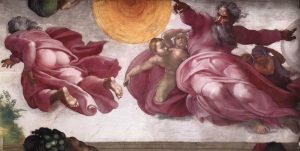 possibly want or need, and they “had nothing to eat but cake and nothing to do but sit in warm pools and busy themselves with the continuation of the species”, that it would not be long at all before people would begin to snap and begin creating havoc and smashing things, just so something different and unexpected would happen. Peterson believes that this is partly due to the hemispherical structure of the psychology of the brain, he elaborates with an admitted oversimplification, but essentially the right hemisphere of your brain is adapted to what you do not know, and the left is adapted to the world that you do know, and the right place to be is halfway between them, with one foot in the known world and one foot in the unknown.
possibly want or need, and they “had nothing to eat but cake and nothing to do but sit in warm pools and busy themselves with the continuation of the species”, that it would not be long at all before people would begin to snap and begin creating havoc and smashing things, just so something different and unexpected would happen. Peterson believes that this is partly due to the hemispherical structure of the psychology of the brain, he elaborates with an admitted oversimplification, but essentially the right hemisphere of your brain is adapted to what you do not know, and the left is adapted to the world that you do know, and the right place to be is halfway between them, with one foot in the known world and one foot in the unknown.
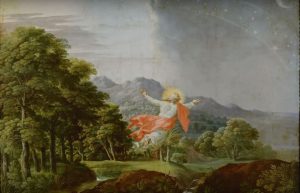 And God said, “Let the waters under the heavens be gathered together into one place, and let the dry land appear.” And it was so. God called the dry land Earth, and the waters that were gathered he called Seas. And God saw that it was good. And God said, “Let the earth sprout vegetation, plants yielding seed, and fruit trees bearing fruit in which is their seed, each according to its kind, on the earth.” And it was so. The earth brought forth vegetation, plants yielding seed according to their own kinds, and trees bearing fruits in which is their seed, each according to its kind. And God saw that it was good. And there was evening and there was morning, the third day.
And God said, “Let the waters under the heavens be gathered together into one place, and let the dry land appear.” And it was so. God called the dry land Earth, and the waters that were gathered he called Seas. And God saw that it was good. And God said, “Let the earth sprout vegetation, plants yielding seed, and fruit trees bearing fruit in which is their seed, each according to its kind, on the earth.” And it was so. The earth brought forth vegetation, plants yielding seed according to their own kinds, and trees bearing fruits in which is their seed, each according to its kind. And God saw that it was good. And there was evening and there was morning, the third day.
And God said, “Let there be lights in the expanse of the heavens to separate the day from the night. And let them be for signs and for seasons, and for days and for years, and let them be lights in the expanse of heavens to give light upon the earth.” And it was so. And God made the two great lights- the greater light to rule the day and the lesser light to rule the night- and the stars. And God set them in the expanse of the heavens to give light on the earth, to rule over the day and over the night, and to separate the light from the darkness. And God saw that it was good. And there was evening and there was morning, the fourth day.
Peterson beings with this particular section of the story by marveling over our ancient ancestors’ ability to look up at the night sky, and notice repeating patterns over time, and to connect the shift in the stars to the changing of the seasons. It is rather evident from ancient sites like Stonehenge, or the pyramids, or any number of other megalithic monuments, that our ancestors were looking up at the stars for enlightenment.
Within these lines, there is also a connection being made between the ruler and the lights within the heavenly expanse. Peterson reiterated a point he made in the previous lecture, that it took us a long time to come to terms with the idea of sovereignty, or at least what constitutes valid power. According to Peterson, it is not power, but authority and the ability to lead people, rather than to dominate them. A ruler should be wise, and lead people in the dark, much light the heavenly lights shine down on the darkness.
Repeatedly throughout the story of creation, it is stated that ‘God saw that it was good.’ And According to Peterson, this is an emphasis on the fact that something is better than nothing. “How do you know that? Well, I guess the answer to that is there’s something instead of nothing.” The fact that there is something probably means there should be something. Right? No one really knows, but Peterson makes the argument that we should see what we can do with it. He believes that it’s a good aim to be on your deathbed and be able to look back and think that there is a little less suffering in the world than there would have been had you never existed.
“And God said, “Let the waters swarm with swarms of living creatures, and let birds fly above the earth across the expanse of the heavens.” So, God created the great sea creatures and every living creature that moves, with which the waters swarm, according to their kinds, and every winged bird according to its kind. And God saw that it was good. And God blessed them, saying, “Be fruitful and multiply and fill the waters in the seas, and let the birds multiply on the earth.” And there was evening and there was morning, the fifth day. And God said, “Let the earth bring forth living creatures according to their kinds- livestock and creeping things and beast of the earth according to their kinds.” and it was so. And God made the beast of the earth according to their kinds and the livestock according to their kinds, and everything that creeps on the ground according to its kind. And God saw that it was good.
Again, there is a re-emphasis on the fact that ‘God said’ and the fact that ‘God said it was good.” ‘God said’ is the representation of the Word, the thing that calls being into existence, the active principle in creating order from chaos. Another thing that is happening in the transition from the Old Testament to the New Testament, is that God in the New Testament is viewed as merciful and full of blessings, while 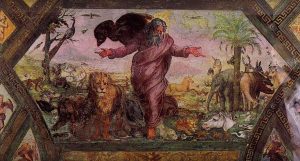 the God in the Old Testament is seen as cruel and arbitrary. This is something which Nietzsche came to agree with. “He felt that the representation of the divine, as a representation of the essential nature of being, was extraordinarily accurate in its arbitrary and often cruel nature.” But in the New Testament, there is a shift in the way you’re expected to act towards God as if he is nothing but good. This is an incredibly strange idea, according to Peterson, because if you look at the world, you don’t have to look far to find terrible things, and it’s difficult to fit the notion of a good God in with all of the atrocities of the world.
the God in the Old Testament is seen as cruel and arbitrary. This is something which Nietzsche came to agree with. “He felt that the representation of the divine, as a representation of the essential nature of being, was extraordinarily accurate in its arbitrary and often cruel nature.” But in the New Testament, there is a shift in the way you’re expected to act towards God as if he is nothing but good. This is an incredibly strange idea, according to Peterson, because if you look at the world, you don’t have to look far to find terrible things, and it’s difficult to fit the notion of a good God in with all of the atrocities of the world.
“But then, the underlying idea is that, if your act in that manner, it makes it more likely to be true.” In other words, if you act as if there is a good God, and that there is good in the world, then there is more capacity for good in the world, and you are active in making that true. Peterson feels that this is expressed, in part, in the idea of Christ’s voluntary sacrifice of his own life. “His presupposition was something like, I’m going to act as if God is good, and I’m going to play it out right to the end. That becomes something like a divine pattern.”
Then God said, “Let us make man in our image, after our likeness. And let them have dominion over the fish of the seas and over the birds of the heavens and over the livestock and over all the earth and over every creeping thing that creeps on the earth.”
Peterson points out the phrasing at the beginning of this passage, noting that the use of “our” comes partly from the Priestly story. In the Priestly story, the idea of God is referred to as Elohim, and it has, what Peterson describes as a kind of plurality of being.
So, God created man in his own image, in the image of God he created him, male and female he created them.
An interesting fact Peterson eludes to is that there is more than one story of creation in Genesis. In this initial story, God makes both man and woman essentially at the same time, and they both carry within them the ‘divine stamp.’ However, in the story of Adam and Eve, Eve is extracted out of Adam.
“And God blessed them. And God said to them, “Be fruitful and multiply and fill the earth and subdue it, and have dominion over the fish of 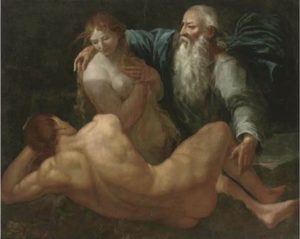 the sea and over the birds of the heavens and over every living thing that moves on the earth.” And God said, “Behold, I have given you every plant yielding seed that is on the face of the earth, and every tree with seed in its fruit. You shall have them for food. And to every beast of the earth and every bird of the heavens and to everything that creeps on the earth, everything that has the breath of life, I have given every green plant for food.” And it was so. And God saw everything he had made, and behold, it was very good. And there was evening and there was morning, the sixth day. Thus, the heavens and the earth were finished, and all the host of them. And on the seventh day God finished his work that he had done, and he rested on the seventh day from all his work that he had done. So, God blessed the seventh day and made it holy, because on it God rested from all his work that he had done in creation.”
the sea and over the birds of the heavens and over every living thing that moves on the earth.” And God said, “Behold, I have given you every plant yielding seed that is on the face of the earth, and every tree with seed in its fruit. You shall have them for food. And to every beast of the earth and every bird of the heavens and to everything that creeps on the earth, everything that has the breath of life, I have given every green plant for food.” And it was so. And God saw everything he had made, and behold, it was very good. And there was evening and there was morning, the sixth day. Thus, the heavens and the earth were finished, and all the host of them. And on the seventh day God finished his work that he had done, and he rested on the seventh day from all his work that he had done. So, God blessed the seventh day and made it holy, because on it God rested from all his work that he had done in creation.”
Peterson relates this to work he has done with people who could be considered workaholics. One of the things he says he spent a decent amount of time talking with people about, is how much should you work? There has to be a healthy balance between work and rest so that you can continue to work. According to him, this is essentially what people have settled on over time, and have given it a sort of divine imprimatur so that we can work for six days and still have at least one day to appreciate life. And this is justified by the idea that even God had to rest at least one day a week, in order to appreciate the world and his work.
Peterson decides to take a step back from the biblical stories themselves, towards the end of the lecture, to go over the attributes of God once more. He feels that it’s important to dwell on this aspect because the goal of these lectures is to attempt to understand what it was that people were trying to formulate when they came up with these representations. We can believe that they are an attempt to abstract out the nature of power and sovereignty, and there is an attempt to associate consciousness with something that has a “cosmic quality”. There is something about consciousness specifically that seems to be “world-generating.”
The hypothesis we currently have is that God is an abstracted ideal, formulated to dissociate the ideal being from any individual man, woman, or ruler. The idea is that when a ruler becomes the ideal, the state in which its ruling becomes something like the tyranny of Biblical Egypt. There is this concept in the Old Testament that if you confused the idea of sovereignty with the current sovereign, then your culture instantly digresses into a totalitarian state, and then to stone essentially.
From the Christian perspective, God has three elements; the Father, the Son, and the Spirit. God the Father seems to be, in part, the representation of tradition and the embodiment of human beings. In between the Father and the Son, often represented as a bird, is the HolySpirit. The spirit is an abstracted sense, and according to Peterson, is possibly the closest Christianity got to the notion of disembodied consciousness. And there is the Son, which “is the notion that tradition and consciousness also have to be embedded into history, in a particular time and place.” This is evident in the incarnation of the perfect man, but also in every individual. It is a reiteration on the notion that being is good, and if you act as if that is so, then the positive influence that you will have on the world would be, in a sense, contagious. And so the Trinitarian notion is essentially that you’re supposed to voluntarily accept the preconditions of the world, and your mortality, and move forward in good faith.
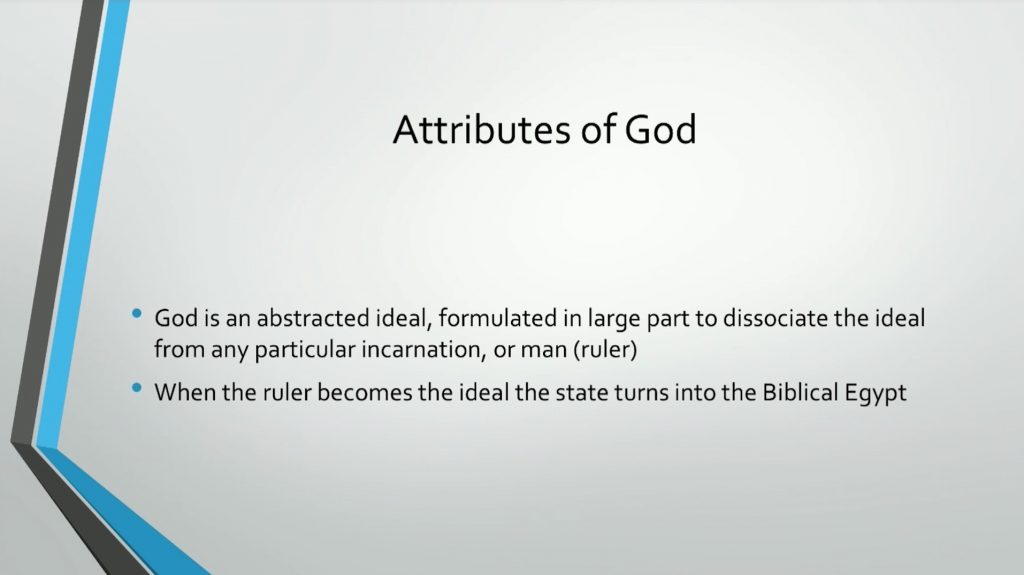
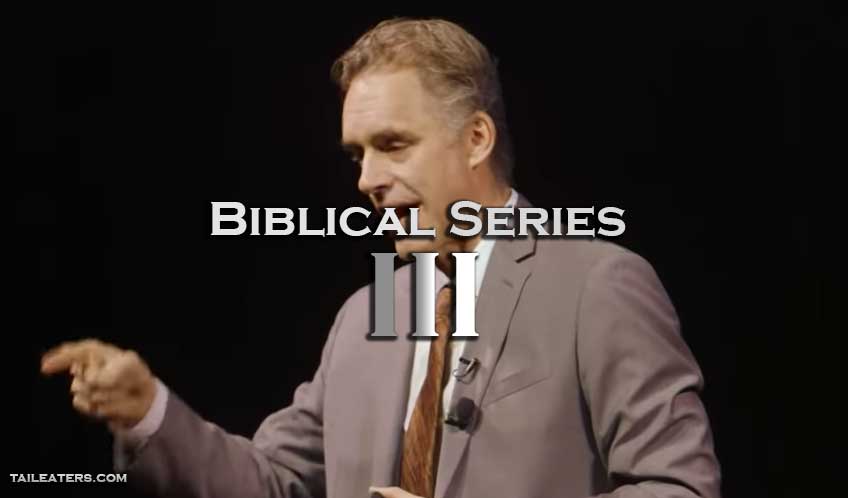
Jordan Peterson’s Biblical Series III
Jordan Peterson's Biblical Series III In May 2017 Dr. Jordan B. Peterson began his 12-part lecture series on the Psychological Significance of the Biblical Stories. With this lecture series he aims to try to better understand and learn about the stories, and the...
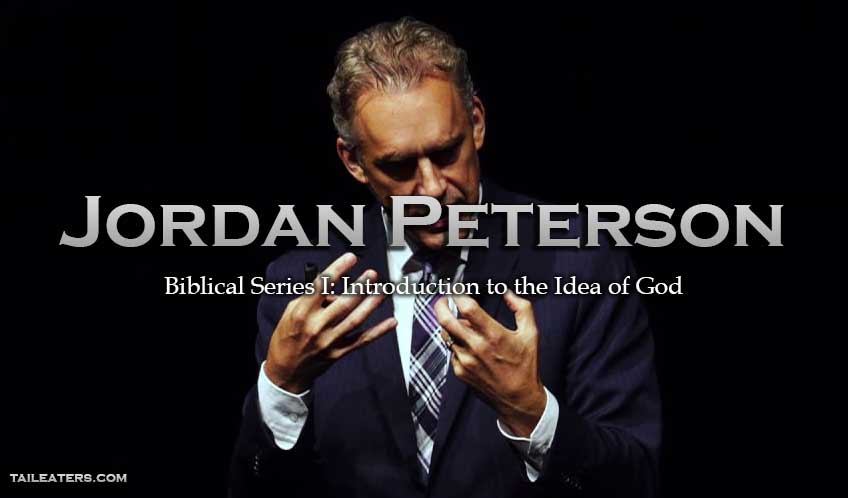
Jordan Peterson Biblical Series
Jordan Peterson's Biblical Series I In May 2017 Dr. Jordan B. Peterson began his 12-part lecture series on the Psychological Significance of the Biblical Stories. With this lecture series he aims to try to better understand and learn about the stories, and the...
Cachet is an early 20’s freelance writer out of the US Midwest. Along with a longstanding passion for writing, she has a great interest in the psychedelics, states of consciousness and the human psyche. Her main interests are in the different dream states, and their influences on the mind, as well as alternative pharmaceutical uses for certain psychedelics.
Join the Discussion
Want to discuss more about this topic and much more? Join our discussion group online and start exploring your consciousness with others like yourself


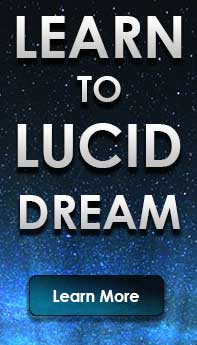
Recent Comments